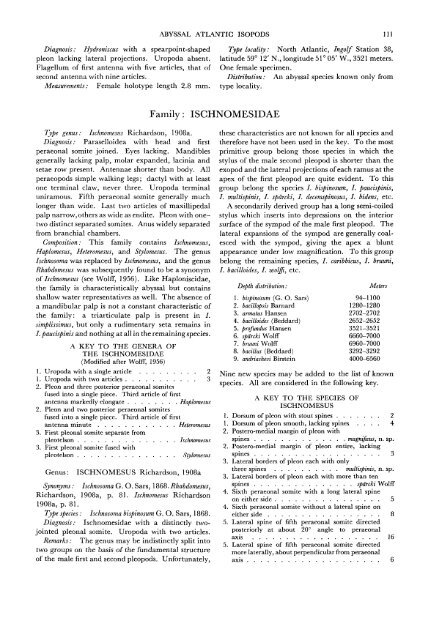The Isopods of Abyssal Depths in the Atlantic Ocean
The Isopods of Abyssal Depths in the Atlantic Ocean
The Isopods of Abyssal Depths in the Atlantic Ocean
Create successful ePaper yourself
Turn your PDF publications into a flip-book with our unique Google optimized e-Paper software.
Diagnosis: Hydroniscus with a spearpo<strong>in</strong>t-shaped<br />
pleon lack<strong>in</strong>g lateral projections. Uropoda absent.<br />
Flagellum <strong>of</strong> first antenna with five articles, that <strong>of</strong><br />
second antenna with n<strong>in</strong>e articles.<br />
Measurements: Female holotype length 2.8 mm.<br />
Type genus: Ischnomesas Richardson, 1908a.<br />
Diagnosis: Paraselloidea with head and first<br />
peraeonal somite jo<strong>in</strong>ed. Eyes lack<strong>in</strong>g. Mandibles<br />
generally lack<strong>in</strong>g palp, molar expanded, lac<strong>in</strong>ia and<br />
setae row present. Antennae shorter than body. All<br />
peraeopods simple walk<strong>in</strong>g legs; dactyl with at least<br />
one term<strong>in</strong>al claw, never three. Uropoda term<strong>in</strong>al<br />
uniramous. Fifth peraeonal somite generally much<br />
longer than wide. Last two articles <strong>of</strong> maxillipedal<br />
palp narrow, o<strong>the</strong>rs as wide as endite. Pleon with onetwo<br />
dist<strong>in</strong>ct separated somites. Anus widely separated<br />
from branchial chambers.<br />
Composition: This family conta<strong>in</strong>s Ischnomesus,<br />
Haplomesus, Heteromesus, and Stylomesus. <strong>The</strong> genus<br />
Ischnosoma was replaced by Ischnomesus, and <strong>the</strong> genus<br />
Rhabdomesus was subsequently found to be a synonym<br />
<strong>of</strong> Ischnomesus (see Wolff, 1956). Like Haploniscidae,<br />
<strong>the</strong> family is characteristically abyssal but conta<strong>in</strong>s<br />
shallow water representatives as well. <strong>The</strong> absence <strong>of</strong><br />
a mandibular palp is not a constant characteristic <strong>of</strong><br />
<strong>the</strong> family: a triarticulate palp is present <strong>in</strong> /.<br />
simplissimus, but only a rudimentary seta rema<strong>in</strong>s <strong>in</strong><br />
/. paucisp<strong>in</strong>is and noth<strong>in</strong>g at all <strong>in</strong> <strong>the</strong> rema<strong>in</strong><strong>in</strong>g species.<br />
A KEY TO THE GENERA OF<br />
THE ISCHNOMESIDAE<br />
(Modified after Wolff, 1956)<br />
1. Uropoda with a s<strong>in</strong>gle article 2<br />
1. Uropoda with two articles 3<br />
2. Pleon and three posterior peraeonal somites<br />
fused <strong>in</strong>to a s<strong>in</strong>gle piece. Third article <strong>of</strong> first<br />
antenna markedly elongate Haplomesus<br />
2. Pleon and two posterior peraeonal somites<br />
fused <strong>in</strong>to a s<strong>in</strong>gle piece. Third article <strong>of</strong> first<br />
antenna m<strong>in</strong>ute Heteromesus<br />
3. First pleonal somite separate from<br />
pleotelson Ischnomesus<br />
3. First pleonal somite fused with<br />
pleotelson Stylomesus<br />
Genus: ISCHNOMESUS Richardson, 1908a<br />
Synonyms: Ischnosoma G. O. Sars, 1868. Rhabdomesus,<br />
Richardson, 1908a, p. 81. Ischnomesus Richardson<br />
1908a, p. 81.<br />
Type species: Ischnosoma bisp<strong>in</strong>osum G. O. Sars, 1868.<br />
Diagnosis: Ischnomesidae with a dist<strong>in</strong>ctly twojo<strong>in</strong>ted<br />
pleonal somite. Uropoda with two articles.<br />
Remarks: <strong>The</strong> genus may be <strong>in</strong>dist<strong>in</strong>ctly split <strong>in</strong>to<br />
two groups on <strong>the</strong> basis <strong>of</strong> <strong>the</strong> fundamental structure<br />
<strong>of</strong> <strong>the</strong> male first and second pleopods. Unfortunately,<br />
ABYSSAL ATLANTIC ISOPODS 111<br />
Family: ISCHNOMESIDAE<br />
Type locality: North <strong>Atlantic</strong>, Ingolf Station 38,<br />
latitude 59° 12' N., longitude 51° 05' W., 3521 meters.<br />
One female specimen.<br />
Distribution: An abyssal species known only from<br />
type locality.<br />
<strong>the</strong>se characteristics are not known for all species and<br />
<strong>the</strong>refore have not been used <strong>in</strong> <strong>the</strong> key. To <strong>the</strong> most<br />
primitive group belong those species <strong>in</strong> which <strong>the</strong><br />
stylus <strong>of</strong> <strong>the</strong> male second pleopod is shorter than <strong>the</strong><br />
exopod and <strong>the</strong> lateral projections <strong>of</strong> each ramus at <strong>the</strong><br />
apex <strong>of</strong> <strong>the</strong> first pleopod are quite evident. To this<br />
group belong <strong>the</strong> species /. bisp<strong>in</strong>osum, I. paucisp<strong>in</strong>is,<br />
I. multisp<strong>in</strong>is, I. sparcki, I. decemsp<strong>in</strong>osus, I. bidens, etc.<br />
A secondarily derived group has a long semi-coiled<br />
stylus which <strong>in</strong>serts <strong>in</strong>to depressions on <strong>the</strong> <strong>in</strong>terior<br />
surface <strong>of</strong> <strong>the</strong> sympod <strong>of</strong> <strong>the</strong> male first pleopod. <strong>The</strong><br />
lateral expansions <strong>of</strong> <strong>the</strong> sympod are generally coalesced<br />
with <strong>the</strong> sympod, giv<strong>in</strong>g <strong>the</strong> apex a blunt<br />
appearance under low magnification. To this group<br />
belong <strong>the</strong> rema<strong>in</strong><strong>in</strong>g species, /. caribbicus, I. bruuni,<br />
I. bacilloides, I. wolffi, etc.<br />
1.<br />
2.<br />
3.<br />
4.<br />
5.<br />
6.<br />
7.<br />
8.<br />
9.<br />
bisp<strong>in</strong>osum (G. O. Sars)<br />
bacillopsis Barnard<br />
armatus Hansen<br />
bacilloides (Beddard)<br />
pr<strong>of</strong>undus Hansen<br />
sparcki Wolff<br />
bruuni Wolff<br />
bacillus (Beddard)<br />
andriashevi Birste<strong>in</strong><br />
94-1100<br />
1280-1280<br />
2702-2702<br />
2652-2652<br />
3521-3521<br />
6660-7000<br />
6960-7000<br />
3292-3292<br />
4000-6560<br />
N<strong>in</strong>e new species may be added to <strong>the</strong> list <strong>of</strong> known<br />
species. All are considered <strong>in</strong> <strong>the</strong> follow<strong>in</strong>g key.<br />
A KEY TO THE SPECIES OF<br />
ISCHNOMESUS<br />
1. Dorsum <strong>of</strong> pleon with stout sp<strong>in</strong>es 2<br />
1. Dorsum <strong>of</strong> pleon smooth, lack<strong>in</strong>g sp<strong>in</strong>es . . . . 4<br />
2. Postero-medial marg<strong>in</strong> <strong>of</strong> pleon with<br />
sp<strong>in</strong>es magnificus, n. sp.<br />
2. Postero-medial marg<strong>in</strong> <strong>of</strong> pleon entire, lack<strong>in</strong>g<br />
sp<strong>in</strong>es 3<br />
3. Lateral borders <strong>of</strong> pleon each with only<br />
three sp<strong>in</strong>es multisp<strong>in</strong>is, n. sp.<br />
3. Lateral borders <strong>of</strong> pleon each with more than ten<br />
sp<strong>in</strong>es sparcki Wolff<br />
4. Sixth peraeonal somite with a long lateral sp<strong>in</strong>e<br />
on ei<strong>the</strong>r side 5<br />
4. Sixth peraeonal somite without a lateral sp<strong>in</strong>e on<br />
ei<strong>the</strong>r side 8<br />
5. Lateral sp<strong>in</strong>e <strong>of</strong> fifth peraeonal somite directed<br />
posteriorly at about 20° angle to peraeonal<br />
axis 16<br />
5. Lateral sp<strong>in</strong>e <strong>of</strong> fifth peraeonal somite directed<br />
more laterally, about perpendicular from peraeonal<br />
axis 6

















